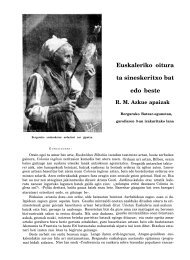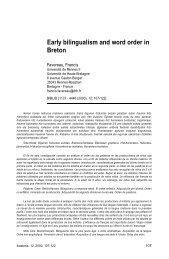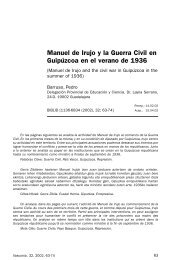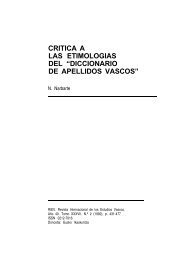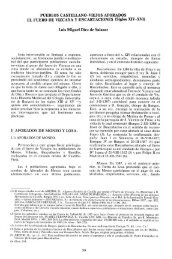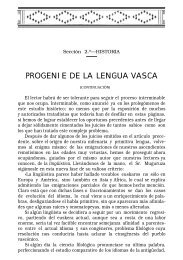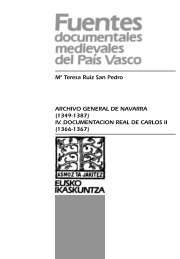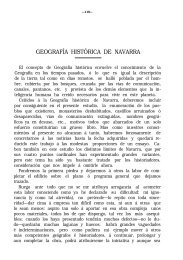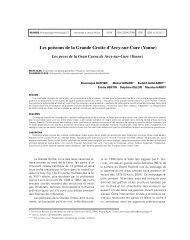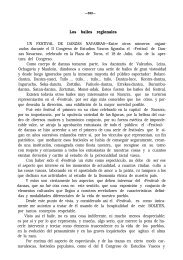conservacion y restauracion
conservacion y restauracion
conservacion y restauracion
You also want an ePaper? Increase the reach of your titles
YUMPU automatically turns print PDFs into web optimized ePapers that Google loves.
Se trata de explicar someramente, el proceso de degeneración de las obras de arte y la acción de los agentes<br />
que lo producen, como la humedad, la luz, las sales, etc., así como de describir dicho proceso de alteración y destrucción.<br />
Dado que las obras de arte se realizan sobre diferentes materiales, veremos cómo inciden, dichos agentes<br />
de destrucción, sobre la propia naturaleza de ciertos soportes, tales como la madera, la tela y la piedra.<br />
La Conservación y la Restauración, son dos actividades creativas emparejadas, que tratan de salvar nuestro<br />
Patrimonio Histórico-Artístico. Describimos cuál es su fundamento teórico, en qué consiste cada una de ellas, cuál<br />
es su función y las diferentes técnicas que existen para su realización.<br />
Actualmente, existen técnicas auxiliares, tanto en referencia a los métodos de examen (rayos X, rayos<br />
infrarrojos, etc.), como a los de laboratorio (cromatografía, etc.), que son vitales en el proceso de Restauración/<br />
Conservación, ofreciendo gran información sobre aspectos puntuales de la obra.<br />
Artelanen endekatzeprozesua eta beronen eragileak, hala nola hezetasuna, argia, gatzak, etab., modu laburrez<br />
azaltzea da lan honen helburua, aipaturiko aldaketa eta suntsipen prozesuaren deskribapena ere egin nahi delarik.<br />
Artelanak material desberdinez eginak izanik, suntsipen-eragile horiek euskarri desberdinen natura bera, hau<br />
da, zura, mihisea eta harria nolatan ukitzen duten ikusiko dugu.<br />
Kontserbazioa eta Errestaurazioa, parekaturik doazen bi sormen-iharduerok gure Ondare Historiko Artistikoa<br />
babestea dute helburu. Beralen oinarri teorikoa azaltzen dugu hemen, zertan datzan bakoitza, haien funtzioa zein<br />
den eta beraiek burutu ahal izateko dauden teknika desberdinak.<br />
Egungo teknika laguntzaileak, baiazterbideetan (X izpiak, izpi infragorriak, etab.), bai laborategiko metodoetan<br />
(kromatografia, etab), guztiz premiazkoak gertatzen dira Errestaurazio/Kontserbazio prozesuan, obraren alderdi<br />
puntualei buruzko informazio handia ematen bait dute.<br />
This is meant to be a brief explanation of the decaying progress of works of art and the action of the agents<br />
producing it, such as moisture, light, salts, etc., as well as to give a description of this altering and damaging process.<br />
As works of art are made of or applied onto different materials, we’ll verify how those destructive agents affect<br />
the natural features of certain materials, such as wood, cloth or stone.<br />
Preserving and Restoring are two creative activities, linked to cachother, both intending to save our History<br />
and Art Heritage. We’ll describe their theoretic basis, what either of them consists of, what their function is and<br />
the actual techniques which are used to achieve this aim.<br />
At present we dispose of auxiliary techniques, both for research methods (X-rays, infrared rays, etc.) as for<br />
laboratory methods (chromatography, etc.) which are essential for the restoring/preserving process, as they provide<br />
a lot of information about specific aspects of the work.<br />
179




